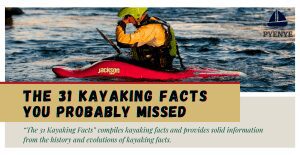When it comes to kayaking suits, it may seem puzzling whether a wetsuit or a dry suit is better for you. Both have their pros and cons, so it really depends on your individual needs and preferences and what type of kayaking you plan on doing.
Wetsuits are great for keeping you warm in cold water, but they can be restrictive and uncomfortable in hot weather. Dry suits, on the other hand, keep you dry and comfortable in all weather conditions but can be more expensive.
In this blog post, we’ll examine the advantages and drawbacks of a typical wetsuit vs a drysuit when it comes to kayaking, including their differences, benefits, and more. Let’s begin with these questions;
It really depends on the weather and the water! If you’re kayaking in cold water, a wetsuit is a way to go. If you’re kayaking in warm weather, a dry suit is a better option.
Yes, a wetsuit is designed to keep you warm in cold water. In fact, wetsuits are an essential piece of gear for any cold water activity, whether you are kayaking or canoeing, surfing, diving, or just swimming.
They will keep you warm in even the coldest water and help you to enjoy your time in the water.
Jump To A Section
Why it’s important for kayakers to understand the difference between wetsuits and drysuits?
If you’re new to kayaking, you might not know the difference between a wet suit and a dry suit.
Wetsuits and drysuits are two completely different types of clothing designed for different purposes.
Wetsuits are made to keep you warm in cold water, while dry suits are made to keep you dry in wet conditions.
Here’s a closer look at the two types of suits and why it’s important for kayakers to understand the difference.
Wet Suits
Wet suits are made of neoprene, a synthetic rubber that is water-resistant and provides insulation. They are available in a variety of thicknesses to suit different conditions and can be worn over other layers of clothing for added warmth.
Wetsuits are used in warm water because they’re less buoyant than dry suits. They also provide UV protection and some warmth. Drysuits are used in cold water because they’re more buoyant than wetsuits. They also provide better insulation.
The main advantage of wet suits is that they keep you warm even when you’re wet. This is because the neoprene traps a layer of water next to your skin, which is then heated by your body temperature. This means that you can stay in the water for longer without feeling cold.
To be frank, wet suits can be uncomfortable to wear for long periods of time and can make it difficult to move around. They can also be difficult to put on and take off, which can be a problem if you need to get in and out of your kayak frequently.
When to Choose a Wetsuit for kayaking?
If you’re kayaking in warm water, a wetsuit is a good choice. They’re less expensive than a dry suit, and they provide a good level of insulation.
Wetsuits are better for long-term immersion
A wetsuit is better for long-term immersion in cold water than a dry suit. It protects the body’s core temperature and is more comfortable to wear when you are not in the water. It is also better for kayaking on large bodies of water, as the water temperature will remain lower than when you were wearing a dry suit.
The Downfalls of Wetsuits
Wetsuits are designed to keep you warm and dry, but they can also be a source of frustration.
Here are some of the downfalls of wetsuits:
They can be uncomfortable
Wetsuits are made of neoprene, which is a synthetic rubber. This material is not breathable, so it can make you feel hot and sweaty. Additionally, the seams of the wetsuit can rub against your skin, causing irritation.
They can be dangerous to wear in the wrong situation
Wetsuits are designed for cold water, but they can be dangerous to wear in warm water. This can lead to dehydration and heat exhaustion.
Dry Suits
Dry suits are made from waterproof and breathable fabrics, such as Gore-Tex. They are available in a variety of styles, including those with zip-up fronts and those that you step into like a pair of trousers.
The main advantage of dry suits is that they keep you dry, even if you fall into the water. This is because the fabric is waterproof and breathable, so it doesn’t allow water to enter or escape. This means that you can stay in the water for longer without getting cold, and you won’t get wet if you do fall in.
However, dry suits can be more expensive than wet suits, and they can be uncomfortable to wear for long periods of time. They can also be difficult to put on and take off, which can be a problem if you need to get in and out of your kayak frequently.
When to Choose a Drysuit?
In short, if you’re kayaking in cold water, a dry suit is a better choice. They keep you warm, even in cold water, and they don’t restrict your movement.
Drysuits are great for the coldest days on the water
Drysuits offer a number of benefits for kayaking, but their main advantages are warmth and ease of use. They provide full body coverage and are easy to put on and remove. Besides, they also provide excellent protection against unexpected dunks and splashes. In addition, dry suits also allow for layering underneath.
Dry suits are also an excellent option for summer kayaking in glacier-fed lakes, where temperatures may stay below 60 degrees throughout the summer.
Drysuits are also great for protecting your skin from abrasion
Drysuits are often thought of as being only for divers, but they have a lot of other great uses. One of the most popular is for protecting your skin from abrasion.
When you are diving, you are constantly coming into contact with things like coral and rocks. This can lead to your skin getting scratched and cut. A dry suit will protect you from this.
Another great use for a drysuit is if you are an avid fisherman. If you spend a lot of time in the water, you will know how important it is to keep your skin protected from the sun. A dry suit will do this for you.
The Downfalls of Drysuits
Drysuits are often lauded as the best way to keep warm and dry in the water. They keep you dry and comfortable in the water, but they can also be a pain to get into and out of.
Here are some of the downfalls of drysuits:
They can leak
Even the best dry suits can leak, especially around the seals. If your suit leaks, you can get cold and uncomfortable very quickly.
They’re expensive
Drysuits can be expensive, especially if you need a custom-made one. If you’re not careful, you can easily spend hundreds of dollars on a suit.
How do you choose A wetsuit Vs a drysuit for kayaking?
When you’re ready to take your kayaking to the next level, you’ll need to choose the right wetsuit or drysuit for your adventure. Here are three things to consider when making your decision:
Consider The type of kayaking you’ll be doing
The first thing to consider is the type of kayaking you’ll be doing. Are you planning on kayaking in calm waters or in rough conditions? If you’re planning on kayaking in rough conditions, you’ll need a dry suit.
A dry suit will keep you dry and warm in the event that you capsize. If you’re planning on kayaking in calm waters, a wetsuit will suffice.
The climate you’ll be kayaking in
The second thing to consider is the climate you’ll be kayaking in. If you’re kayaking in warm waters, a wetsuit will keep you cool. If you’re kayaking in cold waters, a dry suit will keep you warm.
Consider Your Budget
The third thing to consider is your budget. When comparing the budget between a wetsuit vs a drysuit price can range from a few hundred dollars to a few thousand dollars. Choose the wetsuit vs dry suit that fits your needs, and budget.
Learn to measure your body to ensure a perfect fit
Now that you know the three things to consider when choosing between a wetsuit vs a drysuit for kayaking, let’s take a look at how to choose the right size;
When you’re choosing between a wetsuit vs a drysuit, you need to make sure that you choose the right size. The last thing you want is to be uncomfortable or restricted while you’re kayaking.
To know the right size wetsuit or drysuit, you’ll need to take your measurements. To do this, you’ll need a tape measure and someone to help you.
First, you’ll need to measure your chest. To do this, wrap the tape measure around your chest, just under your armpits. Make sure that the tape measure is level and not too tight.
Next, you’ll need to measure your waist. To do this, wrap the tape measure around your waist, just above your hip bones. Again, make sure that the tape measure is level and not too tight.
Finally, you’ll need to measure your inseam. To do this, wrap the tape measure around your leg, from your groin to your ankle.
Once you have your measurements, you can use a size chart to find the right size wetsuit or drysuit. Most size charts will list chest, waist, and inseam measurements.
The Bottom Line
To sum up, wetsuits and dry suits both are essential pieces of gear for kayaking. And to find the quick solution, you will need to compare a wetsuit vs a drysuit according to your kayaking needs.
But for beginners, dry suits offer a number of advantages over traditional wetsuits. For starters, dry suits are much better at keeping you dry, which is obviously a huge benefit when you’re spending extended periods of time in the water.
But drysuits also offer superior thermal protection since they’re not constantly exposing your body to the cold water as a wetsuit does. This is a major benefit for paddlers who are planning to kayak in colder water conditions or who simply want to extend their dive season by being able to dive in cooler water temperatures.
So, if you don’t have a drysuit, then you’re missing out on a key piece of gear that can make your kayaking experience much better.


